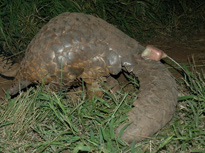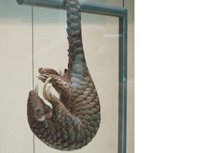Pangolins -- Scales, but not the reptilian type. Ants and termites, will slurpily swipe.



Origins
Pholidota in greek means a horny scale. Their distinctive features are actually bands of armor that look like scales and are made of the same stuff as our nails and hair, namely keratin. The name pangolin comes from the Malay word pengguling ("something that rolls up"). Only one family (Manidae) and one genus survives this once diverse order.
Pangolins were once more widely distributed throughout the world; an essentially modern-looking fossil pangolin, Eomanis, has been found in the Eocene of Germany, and another fossil pangolin has been found in the lower Oligocene of North America. Today, because of habitat destruction and hunting (pangolin scales are used in Chinese and African medicine), the three Asian species and one of the African species of pangolin are considered endangered.
What are they like?
Pangolins resemble armadillos and anteaters, which also feed on insects and have long tongues, strong digging limbs, and reduced or missing teeth. Their resemblance to armadillos is even more striking; both are armored and curl up in response to danger. Yet the armor of a pangolin is different from armadillos. When I first heard of pangolins, wisecracks about age are not funny, they were grouped with armadillos and anteaters in the Edentata, but today the similarities between pangolins and these others are considered to result from convergent evolution. Pangolins are no longer considered close relatives of the armadillos and anteaters, which are now grouped with the sloths in a separate superorder, the Xenarthra.
Geographic Distribution
View Larger Map
Reproduction
Pregnancies among pangolins are relatively long at 120-150 days. African pangolin females usually give birth to a single offspring at a time, but the Asiatic species can give birth to three young ones. Weight at birth is usually 3 to 18 ounces, and the scales are initially soft. The young cling to the mother's tail as she moves about, although, in burrowing species, they remain in the burrow for the first 4 weeks of life. Weaning takes place at around three months of age, and pangolins become ready to reproduce at two years of age.
Feeding Habits
All pangolin species have adapted to life without any teeth and they use their tongue as a limb to fish out insects and termites. A pangolin, very like the ant-eater loves to dig into as many ants as its sticky tongue can pull up. However, in zoos and other conservation facilities, pangolins have been known to enjoy some substitute foods too.
Families within Pholidota
Manidae (Pangolins)
Epoicotheriidae EXTINCT!
Metacheiromyidae EXTINCT!
Videos